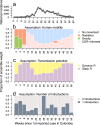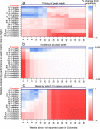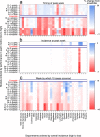Trade-offs between individual and ensemble forecasts of an emerging infectious disease
- PMID: 34508077
- PMCID: PMC8433472
- DOI: 10.1038/s41467-021-25695-0
Trade-offs between individual and ensemble forecasts of an emerging infectious disease
Abstract
Probabilistic forecasts play an indispensable role in answering questions about the spread of newly emerged pathogens. However, uncertainties about the epidemiology of emerging pathogens can make it difficult to choose among alternative model structures and assumptions. To assess the potential for uncertainties about emerging pathogens to affect forecasts of their spread, we evaluated the performance 16 forecasting models in the context of the 2015-2016 Zika epidemic in Colombia. Each model featured a different combination of assumptions about human mobility, spatiotemporal variation in transmission potential, and the number of virus introductions. We found that which model assumptions had the most ensemble weight changed through time. We additionally identified a trade-off whereby some individual models outperformed ensemble models early in the epidemic, but on average the ensembles outperformed all individual models. Our results suggest that multiple models spanning uncertainty across alternative assumptions are necessary to obtain robust forecasts for emerging infectious diseases.
© 2021. The Author(s).
Conflict of interest statement
The authors declare no competing interests.
Figures






